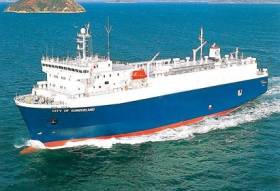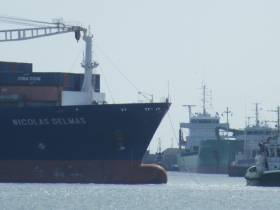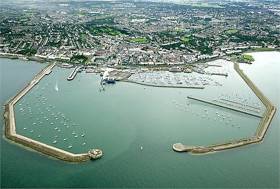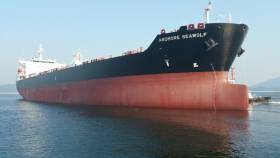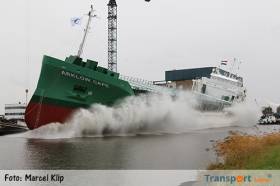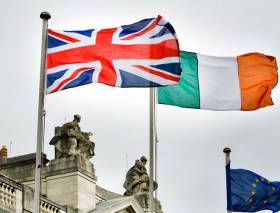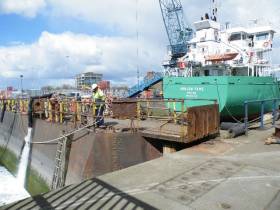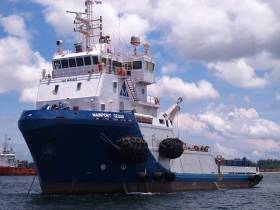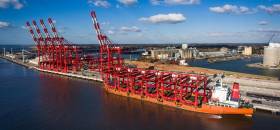Displaying items by tag: Ports & Shipping news
Nissan To Stay Decision in UK Averts 'Catastrophic' Consequences
#CarImports - Afloat earlier this month reflected on Ireland-Bristol Channel routes past and present serving the UK motor industry and of Nissan that denied speculation it would move from its major plant in Sunderland to Cork following Britain's vote on Brexit. The Japanese car-giant writes The Guardian have confirmed they will remain manufacturing in the English north-east city.
The importance of Nissan’s decision to make the new Qashqai and X-Trail models in Sunderland cannot be overstated. Since the referendum on 23 June, when 61.3% of the city’s voters opted for Brexit, a heavy air of anxiety has hung over the city, its economic future heavily tied to the car giant.
Few of the city’s politicians, voters or business leaders believed Nissan’s veiled threat that it could leave the city if it did not receive urgent guarantees from Theresa May.
After all, it is the most efficient car factory in Europe, producing 115 cars an hour – half a million a year – and is the home of Qashqais, Jukes, Notes, Leafs, Infiniti Q30s and now the new X-Trail.
Uprooting those finely-tuned production lines to Spain or Russia, where it has other factories, was almost unthinkable. “It is too big to leave,” was also a common view on the doorstep.
The Guardian has more on the story here Also to read of Dublin Port's 9.8% rise in new vehicles imports on the same period (first nine months) last year, in which demand for this trade shows little sign of abating.
IMDO Announces New Appointments to Key Management Positions
#IMDOappointments - The Irish Maritime Development Office (IMDO) announcement of two new appointments to key management positions has been welcomed here on Afloat.ie, which offers the only regular ports & shipping coverage.
Dr Edel O’Connor joins the IMDO as Business Development Manager and Kelli O’Malley as Marketing & Communications Manager. Their appointments to the organisations management team were made in recent weeks. The government agency is responsible in providing dedicated support to national and international maritime business sector in Ireland.
Dr Edel O'Connor, Business Development Manager, IMDO
Edel holds a doctorate in computer science from DCU and recently received a Diploma in Management from the Irish Management Institute. Over the past number of years, Edel has led the strategic development and implementation of the national marine technology programme and associated SmartOcean initiative. This programme has worked to ‘marinise’ Ireland’s existing strengths across ICT and engineering to drive innovation in new areas of the blue economy.
In this role, Edel spearheaded a number of highly successful events promoting Ireland's digital ocean opportunity and enabling technology companies to drive new forms of innovation in marine using Ireland as a test-bed. Edel also led the development of international partnerships across research and industry, supporting the growth of Ireland’s reputation as an attractive place to do business in this sector. Edel has also been closely involved with the strategic development of actions associated with Harnessing Our Ocean Wealth, and in particular supported the work of the Development Task Force.
Kelli O'Malley, Marketing & Communications Manager, IMDO
Kelli has responsibility for the planning and implementation of the IMDO’s marketing and communications activities both in Ireland and abroad.
Similar roles were held by Keli with the Institute of Directors in Ireland, Chambers Ireland and various PR agencies. Kelli holds an M.A. in Public Relations from Dublin Institute of Technology, a B.A. in English & Economics from UCD and a Certificate in Public Affairs from the Public Relations Institute of Ireland (PRII).
Commenting on the new appointments, Liam Lacey, Director of the IMDO, said: “I am delighted to welcome Dr Edel O’Connor and Kelli O’Malley to the IMDO team. The knowledge, experience and expertise that Edel and Kelli bring to the organisation further strengthens our position to provide top class support to national and international maritime businesses based in Ireland and those considering doing business here. I very much look forward to working with Edel and Kelli in continuing to achieve our aim of being the focal point for maritime business in Ireland.”
#Transfer - Minister for Transport has said in the Seanad the transfer of governance of Dún Laoghaire Harbour Company to the local council is imminent, writes The Irish Times.
Minister Shane Ross said he understood the company and Dún Laoghaire-Rathdown County Council had established transitional teams which were working on the practical issues associated with the transfer. (See: Regional Ports Transfer)
He said officials from his department had met both sides on a number of occasions to assist in the process. “I have also met with many local groups,’’ he added.
Mr Ross said the company faced a challenging financial and operating environment as it moved from commercial shipping activities towards a different operating model, with the focus on marine leisure and marine-related tourism.
Stena Line’s departure from Dún Laoghaire Harbour added to the future challenges to the company. “The financial impact on the port is significant and it is very clear that the company faces a very different operating environment than it faced in the past,’’ he said.
For more on the commercial future of the harbour, click here
As previously reported on Afloat.ie, a Public Meeting regarding the proposed giant cruise liner berth is scheduled today, Thursday 27 October at 7pm in the Royal Marine Hotel. Speakers including Richard Boyd Barrett TD and Cllr Melissa Halpin will outline the two main options for the Government as the SOS movement sees it.
Ardmore Shipping Selects UK P&I Club
#Ardmore - Ardmore Shipping operators of chemical and product tankers (25,000 to 50,000dwt) has selected the UK P&I Club as its second P&I club.
On the back of the steady growth in the size of the Ardmore fleet which now stands at 27 ships, Ardmore decided to select a second club to provide Protection and Indemnity cover.
Commenting on the decision, Georgina Alderman, Ardmore’s Marine and Insurance Manager, said: “We looked at a number of options, including other UK based clubs, but we felt that the UK Club represented the best fit with our requirements, as well as with our ethos as an owner and operator committed to the highest standards of commercial and operational practices.
She added "We are looking forward to working together with the UK Club as an important partner for Ardmore Shipping.”
The UK Club will provide cover for three ships in Ardmore’s fleet.
As previously reported on Afloat, Jorge Lavin was recently appointed as the company's Financial Controller.
Launch and Disposals At All Changing Mixed Flagged Fleet
#CapeLaunch – A cargoship was launched today for Irish owners as the second of 10 in a new series from a shipyard in the Netherlands, writes Jehan Ashmore.
Ferus Smit’s Dutch yard in Westerbroek, is where the single hold 5,054dwt cargoship, Arklow Cape (yard No. 435) slid into the canal. The 'C' class newbuild of 2,999grt is to be delivered next month to Arklow Shipping Ltd. Leadship, Arklow Cadet made her entry onto the same waterway in June.
It is pleasing to see that ASL have the newbuild with an Irish port of registry, that been her owners homeport in Co. Wicklow. This is not the case for their subsidiary, Arklow Shipping Nederland B.V. as their vessels are registered in Rotterdam.
More newbuilds will join this Dutch fleet as 10 ‘V’ class cargoships are on order also in this country. A fifth sister of 5,100dwt is under completion, in which Afloat can reveal is named Arklow Valour.
The newbuild programme has also seen ASL make disposals, most recently the 2002 built Arklow Rose. She was sold to UK owners, Charles M. Willie & Co. (Shipping) Ltd of Cardiff, Wales.
As for bulker, Arklow Willow (which almost a year ago dry-docked in Dublin) has according to the Maritime Insitute of Ireland been disposed in recent months to Canadian interests.
The South Korean built 14,000dwt bulker dating to 2004 made her delivery voyage to Lake Ontario, having been sold to McKeil Marine, Hamilton. The family owned firm are traditionally tug operators on the Lawrence Seaway.
She was renamed Florence Spirit and is operating out of Toronto to Newfoundland.
Irish Exports to UK Fall €300m in First 8 Months of 2016
#IrishEXports - A total €9.5bn worth of goods were exported to the United Kingdom in the first eight months of this year, according to the Central Statistics Office (CSO).
As reported on Newstalk, this represented a €300m drop from the €9.8bn it exported to Great Britain and Northern Ireland in the same period in 2015. This suggests that the Brexit vote and weakening sterling are starting to have an impact.
The new CSO data also shows we were importing less from the UK, down to €10.59bn for the first eight months of the year compared to the €11.53bn spend for the same period in 2015.
Ireland is the UK’s fifth largest trading partner. However, the value of Ireland's seasonally-adjusted goods exports fell by 11.5% following the UK's decision to leave the EU.
The price of the sterling also continues to drop, as Irish exporters face an uncertain future due to Brexit.
For more statistics click here
#Lamentable – The decision to close the largest graving dock in the state in Dublin Port has been described as ‘lamentable’ by the Maritime Institute of Ireland, writes Jehan Ashmore.
According to the M.I.I.’s latest biannual newsletter, the Institute expresses concern that the closure could result in work being lost to Ireland “with the lamentable decision to close and in-fill the big Dublin Graving Dock No.2 which was in constant use by Arklow Shipping”.
It is almost exactly six months ago that Afloat.ie reported the closure of the country’s largest drydock, at 220m long. The ship-repairer and conversion firm, Dublin Graving Docks ceased operations officially on 29 April with the loss of a skilled labourforce of 26 marine engineering personnel. The business had been operated by DGD under license from the Dublin Port Company.
The Institute added “this valuable overhaul and survey work would be lost to the State. It is the biggest such facility in the Republic and was opened in 1957 in style by the then President Sean T.O’Kelly as befitted such an iconic State-funded enterprise”.
Furthermore, in the Autumn newsletter article, the Institute said hopefully, wise counsel will prevail and this valuable maritime facility will be retained on the east coast in the country’s major port.
The last ship, however to use the facility, was aptly an Irish flagged cargoship, Arklow Fame (pictured above) that occupied the graving dock before floated-out on 27 April.
Dublin Port Company are to incorporate the graving dock by infilling to make additional quay frontage and cargo space for the €227m Alexandra Basin Redevelopment.
The ABR project is to enable considerably larger deep drafted cargoships to enter the port. In addition to accommodate giant cruiseships by berthing much closer to the city-centre.
The newsletter also commented that Arklow Shipping has since seemed to be trying out Cork Dockyard. It the next largest such facility in this state which received former business of DGD through the Arklow Rose, which Afloat first highlighted in July.
This former Dutch flagged member of the ASL fleet however upon completion of drydocking emerged as Celtic Venture having been sold to UK based owners.
Shipping Review: Exports €140bn Ahead of Brexit, Irish Ports to Avoid ‘Hard Border’ & Ardmore Appointment
#ShippingReview - Jehan Ashmore reviews the shipping scene from among the following stories over the last fortnight.
In the 'Top 150 Born in Ireland' report, according to the Irish Exporters Association (IEA) the leading largest indigenous companies in that sector generated around €140bn in turnover last year.
The UK Government proposed to transfer frontline immigration controls to Irish port and airports, in measures to avoid enforcing a Brexit ‘hard border’ between the North and the Republic.
Ardmore Shipping Corporation appoints new Financial Controller, Jorge Lavin. The company operates a fleet of chemical and product tankers.
#UNship - Mainport Cedar, which carried out a UN World Food Program to war-torn Yemen is on her first visit to Cork City where her Irish owners are based, writes Jehan Ashmore.
It was during the 9 month contract to the UN that the seismic support vessel which also is a supply ship carried out the unusual role of making humanitarian transportation voyages. The charter of the ship to the Arab country ceased earlier this year.
Mainport Cedar has accommodation for 50 (10 officers and 40 marine crew) and a 1-bed hospital unit. During its UN charter role, the vessel transported UN personnel to Yemen.
As previously reported the 1,659 gross tonnage ship is the leadship of a pair built in Malaysia as the first purpose built seismic support ships for the Mainport Group. The 2013 built ship is berthed at Cork along Albert Quay, adjacent to the Port of Cork’s City Centre Marina.
The reason for the first call of the 53m vessel is due to the completion of a project in the Bristol Channel.
As for the next project, it would appear that Mainport Cedar is next bound for Nassau, Bahamas, though Mainport declined to confirm that the Caribbean island is the next area of operation.
Operating much closer to home, Mainport have the contract to serve the Kinsale Gas Field. This is carried out by the multi-role support vessel Pearl out of Ringaskiddy, lower Cork Harbour. It was here that Celtic Fergus, the latest acquisition for subsidiary Celtic Tugs was delivered by cargoship earlier this year.
#GiantCranes - The last batch of giant cranes for the Irish Sea's newest container terminal, the £400m Liverpool2 deep-water port development arrived by sea from China onto the River Mersey in recent days.
In May, Afloat reported on the first delivery from China of the cantilever rail-mounted gantry (CRMG) cranes that will be used at the biggest container terminal on the Irish Sea. The facility will cater for larger capacity and deeper-draft containerships.
Mark Whitworth, chief executive of Peel Ports, said: “These cranes are the final major piece of the infrastructure jigsaw as we approach the formal opening next month".
“Liverpool2, supported by our wider logistics offering and the port’s strategic location, will provide many shippers with a route to UK and Irish markets that helps them to cut costs, congestion and carbon emissions.”
The Chinese manufacturer ZPMC, also supplied the five ship-to-shore cranes and other CRMGs already on site, these six complete the set of 12 required for phase 1 of the terminal. Ultimately the site will have eight STS and 22 CRMG cranes as part of a £100m equipment investment.
Each of the cranes will be capable of performing an average of 20 moves per hour, with semi-automated control linked to the port’s new Navis N4 terminal operating system. They have a 40 tonne under-spreader capacity and a maximum container lift height above quay level of 21m under spreader (6+1 containers).
In August the cranes originally set off from Nantong on board the Zhenhua 8, passing south-east Asia, India, the Arabian Peninsula and through the Suez canal en route to Liverpool in a 49 day journey of over 20,000km (13,730 m, 11,930nm).


























